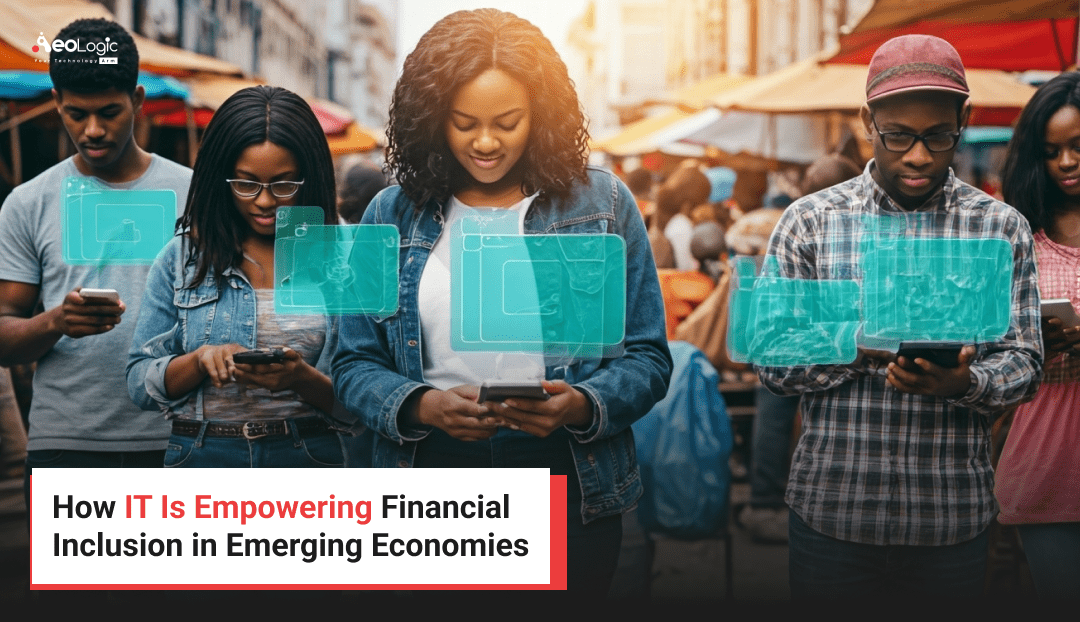Providing financial services to everyone is vital for inclusive growth in emerging economies. Financial inclusion means more than opening bank accounts—it unlocks access to credit, payment systems, savings, and insurance for people and businesses traditionally excluded from the financial system. The rise of digital financial services, fueled by IT, is making affordable financial products available in even the most remote locations. This shift not only drives economic development but also builds resilience and fosters equal economic opportunities for all.
The Landscape of Financial Inclusion in Emerging Economies
Across developing countries, financial inclusion is pivotal for sustained economic growth. The World Bank’s Global Findex data shows that, as of 2021, 76% of adults worldwide held a bank account, a significant improvement driven by digital finance. Yet, many still lack full access to essential financial tools.
Progress remains uneven, especially in low-income areas where traditional financial services are scarce. Achieving full financial inclusion means not just access but active usage of accounts, credit, and insurance. So, how is information technology (IT) specifically driving financial inclusion in emerging economies today? Let’s explore the case of India for deeper insight.
Defining Financial Inclusion and Its Importance in India
Financial inclusion means ensuring individuals and businesses can access and use affordable financial products and services—like savings, credit, and insurance—in a responsible manner. In India, the concept has evolved from simply promoting bank accounts to empowering citizens to make informed financial decisions. Financial literacy plays a critical role, equipping people with the knowledge to use financial services efficiently.
The benefits of financial inclusion are profound. Access to bank accounts and digital payment systems allows families to invest in education and healthcare, breaking the cycle of poverty. It also enables small business owners to expand, manage risks, and contribute to economic growth. As information technology (IT) spreads, the reach of financial services deepens, cutting across social and economic barriers.
Inclusion is not just about economic gains. It also fosters resilience, empowers women, and strengthens communities by providing secure and accessible tools for daily financial activities. IT’s influence is clear—it is rapidly transforming how India and similar economies empower their people financially.
Current State and Key Metrics of Inclusion in Indian Context
India has seen remarkable gains in financial access, thanks to widespread adoption of digital platforms and a proactive national policy. Despite this, challenges persist—especially for rural and low-income populations who face limited access to financial service providers.
Many Indians now own bank accounts, yet the use of digital financial services lags in some regions. Economic participation grows when individuals can actively use these accounts for savings, payments, and credit. Examining the following metrics reveals progress and ongoing gaps:
| Metric | 2011 | 2021 |
| Adults with bank accounts | 35% | 78% |
| Gender gap in account ownership | 20% | 6% |
| Use of digital financial services | 12% | 45% |
| Bank branches per 100,000 adults | 10 | 15 |
| National financial literacy rate | 20% | 30% |
India’s story shows that, while IT and digital platforms have expanded financial access, ongoing efforts are needed to ensure that all citizens can fully participate in economic growth.
The Transformative Role of IT in Expanding Financial Access
Information technology has become the backbone of financial access in emerging economies. Robust digital infrastructure, innovative mobile money solutions, and integrated payment systems now enable millions to participate in the financial system.
For individuals with only a mobile phone, digital finance offers a secure, affordable entry point to banking and other services. This growing digital financial inclusion strengthens economies, boosts household resilience, and increases the reach of financial tools. So, how are mobile banking and digital payment systems transforming access in underserved communities?
Digital Infrastructure as the Backbone of Progress
Effective digital infrastructure is at the core of financial inclusion. Reliable networks allow financial institutions to deliver payment systems and banking services securely and efficiently, even in remote areas. This infrastructure includes mobile connectivity, cloud computing, and robust cybersecurity protocols.
With these advancements, financial institutions can offer a secure way to save, borrow, and transfer money, regardless of physical location. The expansion of digital payment systems is giving rise to new economic opportunities and empowering previously underserved communities.
“Digital infrastructure is not just about technology—it’s about economic empowerment,” notes Kristalina Georgieva, Managing Director of the IMF. Without these digital foundations, the promise of inclusive growth and broad-based economic activity would remain out of reach. IT’s role is clear: it’s driving progress and transforming the landscape of financial access across emerging economies.
The Rise of Mobile Banking and Digital Payment Systems
Mobile banking and digital payment systems are revolutionizing financial transactions in developing regions. These tools offer a lifeline to those without access to traditional bank branches. Mobile money platforms enable users to send, receive, and save funds using their phones, opening up digital finance to millions.
- Mobile banking platforms allow individuals to check balances, make payments, and access credit instantly.
- Digital payment systems help small businesses accept payments securely, expanding customer reach.
- Mobile money services are especially vital in rural areas, bypassing the need for physical bank infrastructure.
- Increased use of digital finance drives economic opportunities by reducing transaction costs and simplifying money management.
By breaking traditional barriers, these innovations fuel economic participation and create a robust ecosystem where financial inclusion means more than just account ownership—it means genuine empowerment.
Overcoming Barriers: How IT Addresses Key Financial Inclusion Challenges
Despite tremendous gains, many in low-income and rural communities still face significant barriers to full financial access. Common obstacles include limited physical bank branches, inaccessible documentation processes, and affordability issues.
Digital solutions are helping to dismantle these barriers by providing affordable financial products and supporting financial stability and business growth. The next sections detail how IT is tackling challenges related to geography, socioeconomic status, documentation, and identity.
Tackling Geographic & Socioeconomic Accessibility
Geographic isolation and socioeconomic constraints have long limited financial access for millions. In remote villages, traveling to a physical bank branch can be costly and time-consuming, often discouraging participation altogether.
Technology-driven solutions are bridging this gap. Mobile banking and digital platforms bring financial services directly to users’ phones, eliminating the need to travel. Affordable financial products—tailored for low-income users—further promote resilience and economic inclusion.
Communities once excluded from the formal financial system now have a secure way to save, borrow, and manage risks. By breaking down geographic and socioeconomic barriers, IT empowers people to participate in the economy, build assets, and weather financial shocks, fostering lasting growth.
Reducing Documentation and Identity Obstacles with Technology
A lack of documentation and official identification has historically barred millions from opening bank accounts or accessing credit. Digital platforms are transforming this landscape by introducing secure, efficient identity solutions.
Biometric identification systems, such as those used in India, provide a reliable method for verifying users without traditional paperwork. This innovation enables more people to access financial education and participate economically.
Financial service providers now use digital onboarding, streamlining the account creation process and minimizing cumbersome paperwork. By addressing documentation challenges, technology not only improves financial access but also lays the groundwork for greater economic stability and inclusion.
Successful IT-Driven Solutions for Unbanked Populations
Across developing nations, IT solutions are empowering unbanked populations in unprecedented ways. Digital platforms and mobile phones allow financial service providers to reach previously inaccessible communities with digital finance products.
The World Bank’s involvement, alongside innovations like Aadhaar-enabled systems in India, illustrates how targeted IT solutions can rapidly expand financial access. Let’s now examine two prominent examples—Aadhaar and the evolution of UPI, RuPay, and other digital platforms—to see real-world impact.
Case Study: Aadhaar-Enabled Payment Systems in India
India’s Aadhaar initiative has become a cornerstone for digital financial inclusion. By providing over 1.2 billion residents with universal digital identification, Aadhaar simplifies access to financial services—especially for those lacking formal documents.
The Aadhaar-enabled Payment System (AEPS) allows users to perform banking transactions at micro-ATMs using only their Aadhaar number and fingerprint. This seamless integration has enabled millions, even in remote regions, to receive government payments, transfer funds, and access savings accounts securely.
Through Aadhaar, digital finance reaches the unbanked, cutting across socioeconomic divides. Not only does it ensure a secure way to handle financial transactions, but it also empowers individuals to participate actively in the economy. India’s experience is a powerful testament to how IT solutions can reshape financial inclusion for developing countries.
The Impact of UPI, RuPay, and Other Digital Platforms
India’s Unified Payments Interface (UPI), RuPay, and a suite of digital platforms have revolutionized payment systems and economic participation. UPI offers a simple, real-time way to transfer money between banks, making digital transactions accessible to all. RuPay, India’s domestic card network, provides affordable payment options, often targeting low-income users.
These technologies have transformed the way financial transactions are conducted:
- UPI facilitates peer-to-peer and merchant payments via mobile phones, supporting even the smallest of businesses.
- RuPay cards give millions access to digital finance, reducing reliance on cash.
- Digital platforms integrate government services and direct benefit transfers, promoting transparency and inclusive growth.
By fostering economic development and expanding access to financial tools, these innovations are at the heart of India’s digital financial inclusion journey.
The Role of Fintech Companies in Accelerating Inclusion
Fintech companies are pivotal in advancing financial inclusion in emerging markets. By leveraging technology, they offer innovative financial tools and digital finance solutions that support economic empowerment and business growth.
Fintech providers reach unserved segments faster than traditional banks, partnering with the private sector to scale impactful solutions. Their influence is especially pronounced in areas like microfinance, payment systems, and credit, creating new opportunities for economic participation. The following sections detail how fintech drives lending and small business empowerment.
Innovative Lending and Microfinance Platforms
Fintech-led lending and microfinance initiatives broaden access to affordable financial products, particularly for small businesses and underserved individuals. These digital platforms streamline application processes and use alternative data for credit assessment, making loans more accessible.
- Fintech-enabled microloans help entrepreneurs launch or expand businesses, supporting local economic opportunities.
- Automated credit scoring accelerates approvals for those without traditional credit histories.
- Peer-to-peer lending platforms connect borrowers and investors directly, lowering costs.
- Mobile-based microfinance apps facilitate savings, payments, and insurance for low-income users.
By making financial tools more inclusive and adaptable, fintech companies are driving economic empowerment and promoting resilience for millions previously excluded from the financial system.
Fintech’s Influence on Small Business Empowerment
Small businesses are vital engines of economic growth, yet many face hurdles in accessing finance. Fintech companies have transformed this landscape by providing digital platforms tailored to small business needs, enabling faster, more flexible lending.
Fintech solutions reduce paperwork and offer immediate access to working capital, fueling business growth and economic participation. Digital finance platforms also provide tools for inventory management, payment processing, and customer engagement, helping enterprises thrive.
As a result, small businesses can invest in new technologies, expand operations, and hire more workers. This ripple effect boosts economic development at the community level, demonstrating the power of fintech in accelerating inclusive growth across emerging markets.
Partnerships and Ecosystems Fueling IT-Enabled Financial Inclusion
Effective financial inclusion relies on strong partnerships between governments, banks, fintech startups, and NGOs. These collaborations create digital financial inclusion ecosystems that promote digital literacy and reach the last mile.
Public and private sector efforts combine to build robust financial institutions and foster education initiatives, ensuring that all members of society benefit from economic opportunities. Next, we’ll explore successful models for partnership and outreach that drive financial inclusion.
Collaborations Between Governments, Banks, and Startups
Ecosystems for financial inclusion thrive when governments, banks, and startups join forces. Governments set the regulatory framework and drive national financial inclusion strategies, while banks provide the backbone of financial systems.
Startups inject innovation, leveraging digital platforms to reach underserved segments quickly and efficiently. These collaborations have produced scalable solutions—like digital payment systems and microfinance platforms—enabling economic growth and inclusion.
For example, partnerships in India have integrated digital financial services with social welfare delivery, maximizing reach and impact. By working together, these sectors create a fertile environment for inclusive growth, supporting both individuals and small businesses in realizing their economic potential.
NGO-Led Digital Literacy and Outreach Initiatives
NGOs play a critical role in bridging the digital divide and promoting financial literacy among marginalized groups. Their outreach and education initiatives ensure that new digital platforms are accessible and beneficial to all members of society.
- NGOs design financial literacy programs tailored to local needs, promoting responsible financial decisions.
- Outreach campaigns help communities understand the benefits of inclusion and how to use digital financial services.
- Training workshops empower women, youth, and the elderly to actively participate in economic activities.
- Collaboration with financial institutions ensures that products are user-friendly and inclusive.
Through targeted interventions, NGOs help boost digital literacy, drive adoption, and ensure that financial inclusion efforts truly reach the ground level.
Regulatory Environment: Policy Support and Constraints
Government regulation plays a pivotal role in shaping the environment for IT-driven financial inclusion. Regulatory bodies like the Reserve Bank of India (RBI) introduce policies to ensure secure digital adoption and protect consumers.
Sound regulation encourages innovation and creates a level playing field for financial service providers. However, balancing policy support with consumer protection and innovation remains a challenge. The next sections discuss how regulations drive secure digital finance and highlight ongoing challenges.
RBI Guidelines and the Push for Secure Digital Adoption
The Reserve Bank of India (RBI) has been proactive in establishing regulations that foster secure digital financial services. RBI guidelines support the growth of digital payment systems, ensuring transactions are safe, efficient, and accessible.
National policy frameworks encourage financial service providers to innovate while maintaining consumer protection. The focus on transparency, robust authentication, and dispute resolution mechanisms underpins trust in digital finance.
Consumer protection regulations are continually updated to address emerging risks related to digital payments, data privacy, and fraud. By prioritizing a secure way of transacting, RBI’s regulatory environment enables more individuals and small businesses to participate confidently in the digital financial system.
Challenges in Balancing Regulation, Innovation, and Consumer Protection
Balancing regulations, innovation, and consumer protection is complex. Too much regulation can stifle innovation, while lax oversight risks consumer harm. Policymakers must address several challenges:
- Ensuring consumer protection without hindering the development of affordable financial products.
- Creating space for innovative financial service providers while maintaining a secure environment.
- Adapting regulations quickly in response to rapid technological changes.
- Making regulatory requirements clear and achievable for new market entrants.
These ongoing efforts strive to provide a secure and inclusive digital finance ecosystem. By fostering both innovation and security, regulators help ensure that financial inclusion drives economic development in a responsible, sustainable manner.
Conclusion
In conclusion, information technology is a powerful catalyst for enhancing financial inclusion in emerging economies. By providing the necessary digital infrastructure, facilitating mobile banking, and addressing challenges related to accessibility, IT plays a crucial role in unlocking financial opportunities for previously unbanked populations. As we have explored, successful case studies like Aadhaar-enabled payment systems and innovative fintech solutions demonstrate the potential of technology to bridge gaps and empower individuals, particularly in rural areas. The ongoing collaboration between governments, banks, and startups, alongside supportive regulatory measures, will further solidify this progress. Embracing these technological advancements is essential for creating a more inclusive financial landscape. If you’re ready to discover how these changes can impact your financial journey, reach out for a free consultation today!
Frequently Asked Questions
What are the biggest risks of rapid digitization of financial services in rural India?
Rapid growth in digital financial services in rural India carries risks such as low financial literacy, exposure to digital fraud, and weak consumer protection. Without proper safeguards, these challenges can undermine trust and exclude vulnerable populations from the benefits of digital inclusion.
How has improved financial inclusion via IT contributed to poverty reduction?
Improved financial inclusion through IT has enabled millions to access digital platforms, savings, and credit. This economic empowerment increases participation, supports small businesses, and helps families break the cycle of poverty by providing more stable and secure financial tools.
What emerging IT trends might shape the future of financial inclusion?
Emerging IT trends like AI-driven financial tools, expanded mobile banking, blockchain, and new fintech solutions are set to further accelerate digital financial inclusion. These innovations promise greater economic opportunities and deeper access for underserved populations in developing countries.

Currently, as a Senior Manager of Technology, I oversee a dynamic team, ensuring the delivery of high-quality software solutions that meet the evolving needs of our clients. A seasoned technology leader with over a decade of experience in the software development industry, I have been instrumental in driving the end-to-end software development lifecycle since my career inception in 2011.






